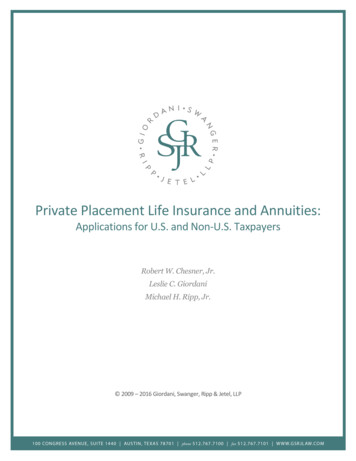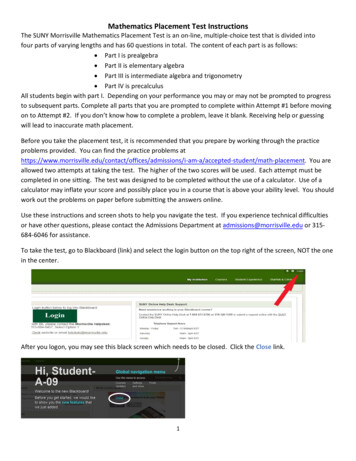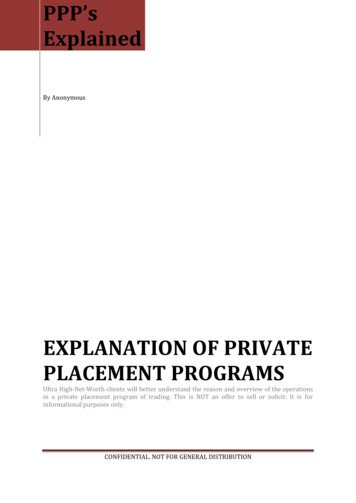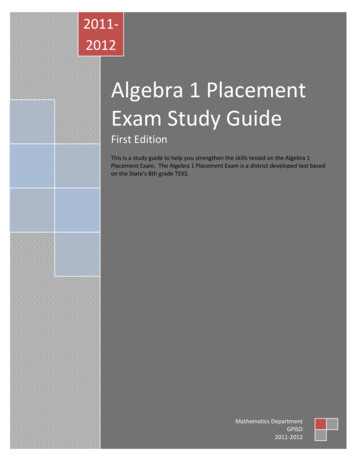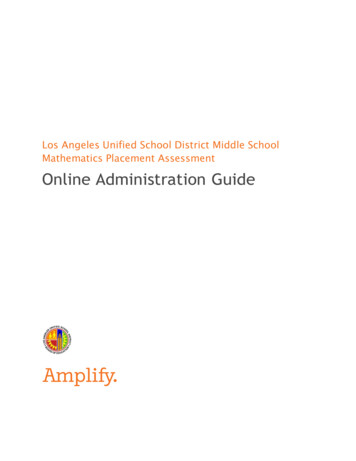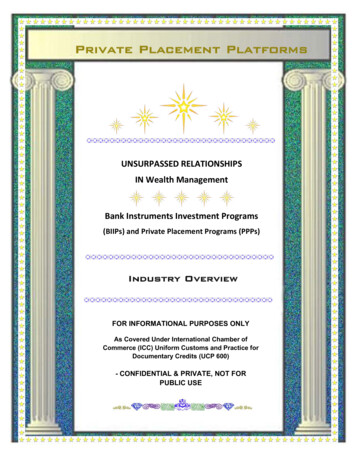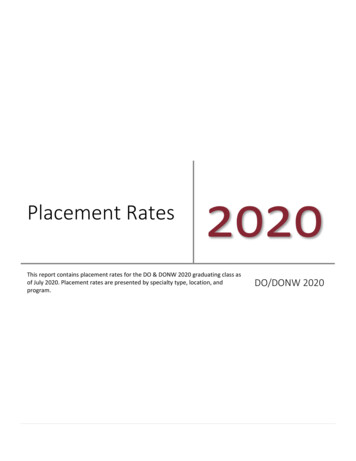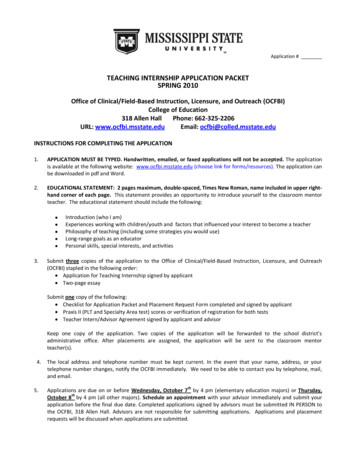
Transcription
Guide to Private Placement Programs (PPP)“ the placement of private funds into a private trade program.”PPP’s can be used to finance major projects inInfrastructure solar wind waste-to-energy/bio-mass hydro hotels/resorts gas/oil agriculture IT/e-commerce transport airlines all other sectorsUnder current regulations it is not necessary to show a project to enter a PPP. It is acceptedby the trading groups that, should you enter a program, your profits will be recycled intofurther wealth creation.PLEASE NOTE: Whilst USD ( ) is used throughout this document, some programs also operate in EUR1 Page
Guide to Private Placement Programs (PPP)CONTENTSPageIntroduction3History3Explanation and Evolution of PPP’s4Large Debt Instruments Market5Platform Trade Performance (demonstration only)5Normal Trading vs Private Placement6Introduction6Arbitrage and Leverage7High Yield – How PPP’s Yield Your Exceptional Profits8Protection of Placement Funds9Non-Solicitation and Non-Disclosure10Next steps102 Page
IntroductionA constant theme running through the global non-bank finance market as it has evolvedsince the 2008 crash, has been private placement programs (PPP’s). Sadly, the whole sectorhas become tainted as unscrupulous individuals, with no real knowledge of how theyoperate, have persuaded the unaware to part with significant sums of money on theexpectation that they were going to reap outstanding returns. So prevalent did these scamsbecome that the FBI and other agencies actually put out warnings that these programs are,in themselves, a scam.Blame the internet, it’s the cause of much grief in the market generally! It’s probably trueto say that less than 1% of what’s on offer on the internet is real. But, nevertheless PPP’sare a genuine, private ‘Tier-1’ market place where financial instruments of many types(mostly MTN’s) are transacted by independent traders and trading groups, operating acrossthe world’s top-tier banks. The market has operated successfully for seven decades.This Guide is written with the intent of assisting those considering entering this market tomake the right decisions. It explains some of the obscure or unclear aspects of PPP’s andhas been prepared from personal experience, and also plagiarizing content from papersproduced by others who, because of the confidential and sensitive nature of theseprograms, prefer to remain anonymous.Before tackling the topic, it is important to understand the basic reasons for the existence ofPPP’s. This document explains the core concept of what money is and how it is created;controlling the demand for money and credit, and the process of issuing a debt note;discounting the note, and selling and reselling it in arbitrage transactions – and how all thisleads to exceptional profits, often used for major project or (private) corporate financing.HISTORYThe history of PPP’s goes back to as far as the 1930’s where it was developed, after theglobal depression, by the USA and Switzerland based on a unique money-lending/creationstructure then operated in Siam (Vietnam). How well it worked (or not) has been lost in theannals of economic history. However, it was re-energised and significantly updated in 1944when the world was reeling from the devastation inflicted by World War II. Economicdestruction, human misery and dislocation existed on an unprecedented scale.This was the world as it existed in July 1944 when 730 of the western world’s mostprominent economic, social and political minds met in Bretton Woods, a small vacationtown in New Hampshire. John Maynard Keynes, who needs no introduction presented aradical plan, based on the Siam experience, to rebuild the world’s economy and, hopefully,avoid a third world war.The world listened and his initiatives eventually led to the establishment of the IMF, Worldand G7. The IMF and World bank regulate a financing structure for which the first majorapplication was the Marshall Plan, which financed the rebuilding of Europe and much of Asiaafter WWII.3 Page
Explanation and evolution of PPP’sMoney CreationFirst and foremost, PPPs exist to ‘create’ money. Money is created by creating debt.For example, you as an individual can agree to loan 100 to a friend with the understandingthat the interest for the loan will be 10%, resulting in a total to be repaid of 110. What youhave done is to actually create 10, even though you don't see that money initially.Don't consider the legal aspects of such an agreement, just the numbers. Banks are doingthis sort of lending every day, but with much more money giving banks the power,essentially, to create money from nothing. Since PPPs involve trading with discounted bankissued debt instruments, money is created due to the fact that such instruments aredeferred payment obligations, or debts. Money is created from that debt.Theoretically, any person, company, or organization can issue debt notes (again, ignore thelegalities of the process). Debt notes are deferred payment liabilities.Example: A person (individual, company, or organization) is in need of 100. He generates adebt note for 120 that matures after 1 year, and sells this debt for 100. This process isknown as ‘discounting’. Theoretically, the issuer is able to issue as many such debt notes atwhatever face value he desires – as long as the buyers believe that he's financially strongenough to honour them upon maturity.Debt notes such as Medium Terms Notes (MTN), Bank Guarantees (BG), and Stand-ByLetters of Credit (SBLC) are issued at discounted prices by major world banks in the amountof -billions every day.Essentially, they ‘create’ such debt notes out of thin air, merely by creating a document.The core problem is that to issue such a debt note is very simple, but the issuer would haveproblems finding buyers unless those buyers ‘believe’ that the issuer is financially strongenough to honour that debt note upon maturity. Any bank can issue such a debt note, sell itat a discount, and promise to pay back the full face value at the time the debt note matures.But would that issuing bank be able to find any buyer for such a debt note without beingfinancially strong?If one of the largest banks in Western Europe sold debt notes with a face value of 1 millionat a discounted price of 800,000 most individuals would consider purchasing one, given thefinancial means and opportunity to verify it beforehand. Conversely, if a strangerapproached an individual on the street with an identical bank note, issued by an unknownbank, and offered it for the same sale price; most people would walk away. It is a matter oftrust and credibility.This also illustrates why there's so much fraud and so many bogus instruments (and thejoker-brokers and dreamers who promote them) in this market.4 Page
Large Debt Instruments MarketAs a consequence of ‘money creation’ above, there is an enormous daily market ofdiscounted bank instruments (e.g., MTN, BG, SBLC, Bonds etc) involving issuing banks andgroups of exit-buyers (pension funds, large financial institutions, etc.) all operating in anexclusive Private Placement arena.All such activities by the bank are done as ‘Off-Balance Sheet Activities’. As such, the bankbenefits in many ways. Off-Balance Sheet Activities are contingent assets and liabilities,where the value depends upon the outcome of which the claim is based, similar to that ofan option. Off-Balance Sheet Activities appear on the balance sheet ONLY as memorandaitems. When they generate a cash flow they appear as a credit or debit in the balance sheet.The bank does not have to consider binding capital constraints, as there is no depositliability.Minimum depositThe minimum deposit to enter a PPP is usually 100 million, however Crossway Capital cansometimes enter clients into programs for 50 million and, if the timing is right 10 million.Large institutions, funds and foundations sometimes deposit funds in their tens of billions tocreate money for major projects, particularly in the developing world. The World Bank, IMFand other global monetary authorities do not have any concerns about the inflationaryeffects of this new money, as it is always absorbed through labour and materials.In these programs, you will enter into a JV with the trade group and have your 50% ofprofits paid to wherever you instruct them to pay it. Alternatively, you will enter into ageneric contract where your profits are simply paid to you from the trading group.It is possible with some of these programs that you will be able to automatically roll-overyour profits - a compound trade. An extraordinarily effective capital enhancement tool.Whereas, many other buy/sell programs required you to withdraw your profits on a regularbasis. It all depends on the jurisdiction and other considerations. Examples of PPP andBuy/Sell Program performance is shown below.PPP Performance (demonstration only):Placement: 100mMonthly Returns:Estimate 100%Frequency:10 Months/40 WeeksTotal Earnings: 1BnThe explanation for how the above yields are delivered across PPP’s are presented in HighYield – How PPP’s Yield Your Exceptional Profits (p8 below).WARNING: Please be aware there are far more fake Buy/Sell deals than there ever are PPP’swhich start from 100m, and with no movement of capital, or kept 100% under ownercontrol. See Protection of Placement Funds (p9 below).5 Page
‘Normal’ trading vs private placementPlease read this section carefully to gain a full understanding of how theexceptional profits associated with PPP’s are generated.IntroductionAll trading programs in the Private Placement arena involve trade with discounted debtnotes in some fashion. Further, in order to bypass the legal restrictions, this trading can onlybe done on a private level. This is the main difference between PPP trading and ‘normal’trading, which is highly regulated. This is a Private Placement level business transaction thatis free from the usual restrictions present in the securities market. It is based on trusted,long-established private relationships and protocols.Normal trading activity is performed under the ‘open market’ (also known as the ‘spotmarket’) where discounted instruments are bought and sold with auction-type bids. Toparticipate in such trading, the trader must be in full control of the funds, otherwise he hasno means of buying the instruments before reselling them.However, in addition to the widely recognised open market there is a closed, private marketcomprising a restricted number of ‘master commitment holders’. These are trusts,foundations and other entities with huge amounts of money that enter contractualagreements with banks to buy a limited number of fresh-cut instruments at a specific priceduring an allotted period of time. Their job is to resell these instruments, so they contractsub-commitment holders, who in turn contract exit-buyers. This form of pre-planned andcontracted buy/sell is known as arbitrage, and can ONLY take place in a private market (thePPP market) with pre-defined prices. Consequently, the traders never need to be in controlof the client's funds.No program can start unless there is a sufficient quantity of money backing eachtransaction. It is at this point that you, the client, is needed because the involved banks andcommitment holders are not allowed to trade with their own money unless they havereserved enough funds, comprising money that belongs to clients, which is never at risk.The ‘host’ trading bank is then able to loan money to the trader against your deposit.Typically, this money is loaned at a ratio of 10:1, but during certain conditions it can be ashigh as 20:1. In other words, if the trader can ‘reserve’ 100 million of client funds, then thebank can loan 1 Billion against it, with which the trader can trade. In all actuality, the bankis giving the trader a line of credit based on how much client funds he controls, since thebanks can’t loan leverage money without collateral.Because bankers and financial experts are well aware of the ‘normal’ open market and ofso-called ‘MTN-programs’, but are closed out of this private market, they find it hard tobelieve that it exists. Bankers in top-tier, global banks (where this trading takes place) areignorant that this trading exists within their own institutions because it happens at a levelfar removed from their own mainstream corporate or retail banking operations.6 Page
Arbitrage and LeveragePrivate Placement trading safety is based on the fact that the transactions are performed asarbitrage. This means that the instruments will be bought and resold immediately with predefined prices. A number of buyers and sellers are contracted, including exit-buyerscomprising mostly of large financial institutions, insurance companies, or extremely wealthyindividuals. The arbitrage contracts, provision of leverage funds from the banks and allsettlements follow long-established and rapid processes.The issued instruments are never sold directly to the exit-buyer, but to a chain of marketparticipants. The involved banks are not allowed to directly participate in thesetransactions, but are still profiting from them indirectly by loaning money with interest tothe trader as a line of credit. This is their leverage. Furthermore, the banks profit from thecommissions involved in each transaction.The client's principal does not have to be used for the transactions, as it is only reserved as acompensating balance (‘mirrored’) against the credit line provided by the bank to thetrader. This credit line is then used to back up the arbitrage transactions. Arbitrage tradingdoes not require the credit line to be used, but it must still be available to back up each andevery transaction.Such programs never fail because they don't begin before arbitrage participants have beencontracted, and each actor knows exactly what role to play and how they will profit fromthe transactions. The trader is usually able to secure a line of credit typically 10 to 20 timesthat of the principal (the client’s deposit). Even though the trader is in control of thatmoney, the money still cannot be spent. The trader need only show that the money isunencumbered (blocked), and is not being used elsewhere at the time of the transaction.This concept can be illustrated in the following example. Assume you are offered the chanceto buy a car for 30,000 and that you also find another buyer that is willing to buy it fromyou for 35,000. If the transactions are completed at the same time, then you will not berequired to ‘spend’ the 30,000 and then wait to receive the 35,000. Performing thetransactions at the same time nets you an immediate profit of 5,000. However, you muststill have that 30,000 and prove it is under your control.Arbitrage transactions with discounted bank instruments are done in a similar way. Theinvolved traders never actually spend the money, but they must be in control of it. Theclient's principal is reserved directly for this, or indirectly in order for the trader to leveragea line of credit.Confusion is common because the perception is that the money must be spent in order tocomplete the transaction. Even though this is the traditional way of ‘normal’ trading - buylow and sell high – and also the common way to trade on the open market for securities andbank instruments, it is possible to set up arbitrage transactions if there is a chain ofcontracted buyers, but only in a private market.This is why client’s funds in Private Placement Programs are always safe and without anytrading risk.7 Page
High Yield – How PPP’s Yield Your Exceptional ProfitsCompared to the yield from traditional investments, PPP’s deliver a very highyield. 25%-100% (or more) per week is possible.And this is how: Assume a leverage effect of 10:1, meaning the trader is able to back each buy-selltransaction with ten times the amount of money that you, the client, has depositedwith the program. In other words, you have 10 million but the trader, because of his leveraged loanwith the bank, is able to work with 100 million. Assume also the trader is able to complete three buy-sell transactions per week,with a 5% profit from each buy-sell transaction:(5% profit/transaction) x (3 transactions/week) 15% profit/weekAssume 10x leverage effect 150% profit.PER WEEKEven with a 50/50 split of profit between you and your trading group,this still results in a double-digit weekly yield.This example can still be seen as conservative, since Tier-1 trading groups, like the onesCrossway Capital can connect you with, can achieve a much higher single spread for eachtransaction, as well as a markedly higher number of weekly trades.8 Page
Protection of Placement FundsNaturally, your first consideration will be the protection of your deposit. There have beenmany scams associated with PPP’s, and the trade groups understand this. However, fromtheir standpoint, they still have to show the funds as being under their ‘control’ to their hostbanks, in order to secure the leveraged funds from that bank, which will deliver theexceptional returns you entered the market to achieve.Different trade groups and the different programs operated between them use a variety ofways to secure your deposit and these range across:Blocked fundsYour funds remain ‘blocked’ in your own account using a SWIFT MT760. An inter-bankmechanism that prevents you using the funds for any other purpose for the period yourprogram is operating.Sole signatoryThe trade group may ask you to move your funds to an account with their host bank (alwaysa global tier-1 institution) where the account will be under your sole signature. No fundscan be moved from the account without your say-so.Non-depletionThe account the traders open for you can also be non-depletion meaning that, no matterwhat, no funds can be taken from your account by anyone – other than you.EscrowSome programs will accept your deposit funds into an escrow account, always with a toptier bank and under the control of an attorney or recognised and/or authorised escrowagent.If you are EVER asked for any kind of up-front fee, under whatever pretext, you aredefinitely not dealing with a genuine trade group or one of their approved introducers. Run.9 Page
Non-Solicitation and DisclosureAs a direct consequence of the PPP environment where these transactions take place, anon-solicitation agreement has to be strictly followed by all parties involved. This agreementstrongly influences the way the participants can interact with each other. Sometimes nonsolicitation agreements foster scam attempts, due to the fact that at an early stage it isoften difficult for the clients to recognize reliable sources to be in contact with.There is another reason why so few experienced people talk about these transactions.Virtually every contract involving the use of these high-yield instruments contains veryexplicit non-circumvention and non-disclosure clauses forbidding the contracting partiesfrom discussing any aspect of the transaction for a specified number of years. Hence, it isvery difficult to locate experienced contacts who are both knowledgeable and willing to talkopenly about PPP’s and the profitability of the transactions in which they figure.Genuine PPP’s are closed to all but those closest to the market. Which includes CrosswayCapital.NEXT STEPSIf you are considering entering a program please send the following information: How much deposit you want to placeYour country of residenceTo PPP@crosswaycapital.com.auPlease also attach: Your proof of funds (POF) in the form of a screen grab of your current statement. Allaccount identifiers can be redacted. The traders are only interested in seeing thename of the bank, your name on the statement, the date and current balance. Theywill not respond to your application unless they see this information. A copy of your current passport.We cannot present you to any group without the above information. They will assess whichis the best current option for you and, usually, come back to you directly within 48-hours,after conducting preliminary due diligence, advising if you can be accepted into a program.Once accepted we recommend you follow their intake and transaction process diligently.Part of that process you will be asked to confirm (and perhaps prove) that your funds havebeen generated legitimately.If you are a wealth manager or other professional you will need to come to a fee shareagreement with Crossway Capital. Once connected with the relevant group’s intakemanager you (and Crossway) will be excluded from all further discussion between them andyour client. Crossway Capital (2017)10 P a g e
All trading programs in the Private Placement arena involve trade with discounted debt notes in some fashion. Further, in order to bypass the legal restrictions, this trading can only be done on a private level. This is the main difference between PPP trading and 'normal' trading, which is highly regulated.
